Abstract
Mobile PDA/phone devices allow remote monitoring of clinical and behavioral parameters. However, passively expecting patients to use these devices may lead to low response rates. Our study, aimed at collecting exercise and symptom data from an older clinical population of patients with COPD, employed push technology principles by delivering automated prompts to patients in an effort to increase response rates. We found acceptable response rates with subjects preferring to have prompts delivered to coincide with their exercise activity though usability issues had adverse effects on response rates and time.
Background
In our pilot study of a web-based dyspnea self-management program (DSMP) for patients with COPD which included exercise and symptom monitoring, we found that subjects tended to not use log on to the web site when they were ill and not feeling well. Web-based diaries, whether used for self-monitoring alone, or as a component of a care management intervention mostly operate on “pull” technology which requires users to initiate a data input session. We were interested in exploring how “push” technology with a PDA/phone device could help users provide more consistent, real-time exercise and symptom data and therefore support more prompt response from a care provider. The purpose of this paper is to present early data on response rate and times by patients with COPD who were equipped with a mobile device that delivered automated prompts asking them to submit exercise and symptom data.
Methods
Patients with moderate to severe COPD who were current Internet users were randomly assigned to one of two 6-month dyspnea self-management programs that had an overall focus on structured education and ongoing motivational support for exercise adoption and maintenance. This analysis is restricted to subjects who were in the Internet-based program (eDSMP). Exercise and symptom prompts were scheduled according to times specified by subjects, which for the exercise prompts mostly corresponded with their planned exercises. Daily symptom recordings were necessary in order to monitor trends in respiratory symptoms indicative of a COPD exacerbation. The research nurse received automatic email alerts if subjects reported a 2-day sustained worsening of symptoms or when subjects responded to fewer than 3 exercise queries over a 7 day period. Early pilot testing found significant usability problems with this device, with subjects having to complete a sequence of 16-30 unique actions on the device to complete an entry. Alternate devices were not possible due to vendor requirements. An electronic game was installed on the device and subjects were encouraged to practice with the navigation widgets for one week before receiving the exercise and symptom prompts
Results
Six eDSMP subjects with a mean age of 73±6 (range 65-80) have completed the 6-month program. The median and range of the response rates and times for the exercise and symptom queries are shown below.
| Response Rate | Response Time (hrs) | |
|---|---|---|
| Exercise | 83.9% (47-89) | 15.8 (4-63) |
| Symptom | 82.3% (67-85) | 20.2 (14-70) |
Delays in the response times were mostly due to diary “hoarding” where several days of data were entered during one single session. One subject reported changing his reporting behavior once he learned of the branching logic for the symptom surveys.
Discussion
These early data show that use of a mobile device for exercise and symptom data acquisition achieved an acceptable median response rate; however response time was delayed. We believe these findings for the most part are specific to the usability constraints of this particular mobile device though we are not ruling out other substantive explanations. While certain behavioral and clinical indicators can be tracked and recorded automatically, patient-reported data are still needed. Careful device selection, attention to usability testing, and parsimony with data capture are keys to successful integration of mobile technology for longitudinal monitoring.
Footnotes
Support from the Robert Wood Johnson Health e-Technologies Initiative, RWJ49153 to Dr. Carrieri-Kohlman and K12 HD049100 from the National Institutes of Health Roadmap/National Institute of Child Health and Human Development to Dr. Nguyen



